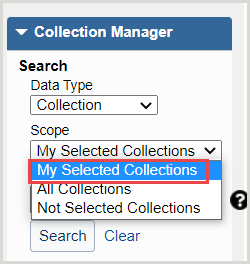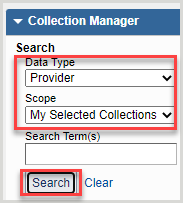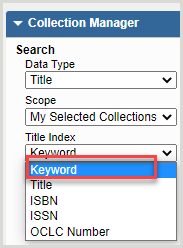Learner guide: Use KBART files to edit WorldCat knowledge base collections
Course overview
This course provides instruction on using KBART (Knowledge Base and Related Terms) files to select, edit, or add knowledge base collections. After this session, learners will be able to create and use a KBART files to edit or add a knowledge base collection in WorldShare Collection Manager.
Note: This learner guide is designed to accompany the Use KBART files to edit WorldCat knowledge base collections course. If you attended the Use KBART files to edit WorldCat knowledge base collections instructor-led course or listened to the recording, please complete our brief survey. Your feedback is very important! Thank you!
Searching in Collection Manager
Search for collections
Search for a provider
Search for a title
Select and edit knowledge base collections with KBART file
Download KBART file
- Under the collection search results, click the desired collection to open it.
- Click Collection Actions menu.
- Select Download titles in this Collection
- Scope = Available titles in collection OR My Selected Titles
- Click Download.
- Save file to edit later or open file to edit in a spreadsheet program.
Edit titles in a spreadsheet program (preferably EXCEL)
- Global vs. Local edits:
- Global changes made to a global field are applicable to all libraries (e.g., Title Name).
- Local changes made to a local field are only applicable to the editing library (e.g., coverage information).
- More information about global vs. local fields can be found at editable knowledge base fields.
- Edit and delete titles to match your library-specific purchase or subscription, include using the VLOOKUP function to reconcile a KBART file.
- Use the appropriate ACTION value.
Use Case Value Description Select a subset of global titles by using a KBART file
Select Use for rows of titles/title data where you did not make changes
Modify a global collection by editing a KBART file
Covoverlay Use for rows of titles/title data where you did not make changes
Modify a global collection by editing a KBART file
Overlay Use for rows of titles/title data where you did not make changes
- Save file as a tab-delimited text file.
Upload KBART file
In the desired collection:
- Click Collection Actions menu.
- Select Upload Titles to this Collection.
- Scope = Update changes only OR Replace all titles in collection
- Click the Browse button and locate the file to upload.
- Click Upload. You will see this message: Upload is being processed.
- View the upload preview report by clicking the provided link.

- Approve or Discard upload.
Add new knowledge base collections with KBART file
Create a new local collection
Under Collection Manager:
- Click Create a Collection.
- Select Knowledge Base Collection.
- Click Create.
New collection screen displays (Required fields marked with a red asterisk (*))
- Properties accordion
- Enter a Collection name.
- Use or change Collection ID.
Note: Your Collection ID needs to be unique. - Search for an existing Provider or Create a Provider.
- Linking accordion
- Enter the Collection URL as appropriate.
- Link scheme - OCLC can create a link scheme for new knowledge base collection and add it here. Provide OCLC Support with the following information:
- Collection name, Collection ID, and Provider
- Sample search from the current provider to full-text
- Username and password
- Click Create to add the new collection.
Add titles to a new collection with a KBART file
- Create a collection of titles in spreadsheet program. Each row contains information for one title.
- Add title using KBART formatting (see section below). See: KBART values and formatting
Note: See the KBART template for reference or to create a collection.
- Use appropriate value in the ACTION field for each title:
Use Case Values Descriptions Create a new local collection or make changes to titles in a local collection
raw Use to tell the system that the title is added for the first time Add titles to a local collection with a KBART and system generated data
autofill Use the OCLC number to find the WorldCat record and populate title - Save KBART file as a tab-delimited text (.txt) file type.
- Add title using KBART formatting (see section below). See: KBART values and formatting
- Upload KBART file of titles
- Select Metadata.
- Expand Collection Manager.
- Search for the desired collection.
- Navigate to the collection screen.
- Click the Collection Actions menu.
- Select Upload Titles to this Collection.
- Scope = Update changes only OR Replace all titles in collection
- Click the Browse button and locate the file to upload.
- Click Upload. You will see this message: Upload is being processed.
- View the upload preview report.

- Approve or Discard the upload.
KBART recommended values by format
To determine KBART values, see KBART recommended values by format.
Promote local knowledge base collections
Libraries can opt to promote a locally created collection the global WorldCat knowledge base.
To promote a locally created collection:
- Under Collection Manager, search for the collection.
- In the collection results screen, open the desired collection.
- Click Collection Actions menu.
- Select Promote Collection to Global Knowledge Base.
- Provide a summary of changes. Click Continue.
- Once request has been submitted, you will see the following message:

- Once the request is accepted and the collection promoted to a global collection, the collection ID and provider will change to:

Delete locally-created knowledge base collection and/or titles
Depending on the changes with your library’s electronic resources subscriptions, you may need to periodically remove selections (holdings) from an entire collection or individual selected titles in a collection created by your library.
Delete an entire collection your library created:
- Under Collection Manager, search for the collection. The Search results screen displays.
- Identify the chosen collection.
- Under Selections, click Delete.
- A confirmation will appear, click Delete button.
Delete individual titles in a locally-created collection:
- Under Collection Manager, search for the collection. The Search results screen displays.
- Identify the chosen collection.
- Click the collection name to display the collection.
- Search for your chosen title(s).
- Under Selections, click Delete Title.
To delete a subset of titles from one or multiple collections, you may choose to use the Title Work List.
Test your knowledge
- Which spreadsheet format should you use when uploading a KBART file to WorldShare Collection Manager?
- Excel (.xlsx)
- CSV (.csv)
- UTF-8 Tab delimited (.txt)
- Google Sheets (.gsheet)
- What must you do with the ACTION column in a KBART file before uploading it?
- Delete it
- Leave it unchanged
- Update it to reflect the intended action for each title
- Move it to the first column
- Which fields are mandatory in a KBART file when creating or modifying a collection?
- publication_title, title_url, coverage_depth, oclc_entry_id
- title_url, ACTION, publisher_name
- coverage_depth, ACTION, ISSN
- publication_title, ACTION, ISBN
- What happens if you delete or reorder columns in a KBART file before uploading?
- The file will upload faster
- The system will ignore the changes
- The upload will fail
- The system will automatically correct the format
- When should you modify a knowledge base collection instead of selecting it in full?
- When your library subscribes to all titles in the collection
- When your library subscribes to only a subset of titles
- When the collection is not available in the global knowledge base
- When the collection is already selected
Additional information
- WorldShare Collection Manager training - Find this class and additional training content here.
- What’s new with WorldShare Collection Manager? Check the WorldShare Collection Manager release notes.
- WorldShare Collection Manager FAQ & Troubleshooting articles
- WorldShare Collection Manager Community Center
- Connect with OCLC staff and peers using WorldShare Collection Manager.
- Share workflows and feedback, and submit enhancement requests.
- Attend webinar events and keep up with product news
Additional questions? Contact OCLC Support.





